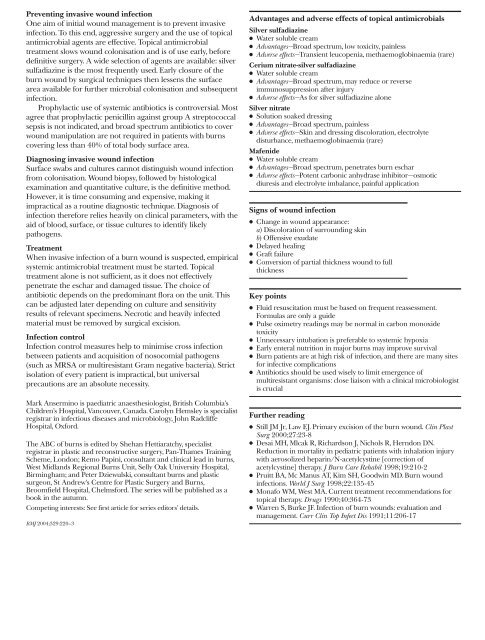ABC of Burns
Create successful ePaper yourself
Turn your PDF publications into a flip-book with our unique Google optimized e-Paper software.
Preventing invasive wound infection<br />
One aim <strong>of</strong> initial wound management is to prevent invasive<br />
infection. To this end, aggressive surgery and the use <strong>of</strong> topical<br />
antimicrobial agents are effective. Topical antimicrobial<br />
treatment slows wound colonisation and is <strong>of</strong> use early, before<br />
definitive surgery. A wide selection <strong>of</strong> agents are available: silver<br />
sulfadiazine is the most frequently used. Early closure <strong>of</strong> the<br />
burn wound by surgical techniques then lessens the surface<br />
area available for further microbial colonisation and subsequent<br />
infection.<br />
Prophylactic use <strong>of</strong> systemic antibiotics is controversial. Most<br />
agree that prophylactic penicillin against group A streptococcal<br />
sepsis is not indicated, and broad spectrum antibiotics to cover<br />
wound manipulation are not required in patients with burns<br />
covering less than 40% <strong>of</strong> total body surface area.<br />
Diagnosing invasive wound infection<br />
Surface swabs and cultures cannot distinguish wound infection<br />
from colonisation. Wound biopsy, followed by histological<br />
examination and quantitative culture, is the definitive method.<br />
However, it is time consuming and expensive, making it<br />
impractical as a routine diagnostic technique. Diagnosis <strong>of</strong><br />
infection therefore relies heavily on clinical parameters, with the<br />
aid <strong>of</strong> blood, surface, or tissue cultures to identify likely<br />
pathogens.<br />
Treatment<br />
When invasive infection <strong>of</strong> a burn wound is suspected, empirical<br />
systemic antimicrobial treatment must be started. Topical<br />
treatment alone is not sufficient, as it does not effectively<br />
penetrate the eschar and damaged tissue. The choice <strong>of</strong><br />
antibiotic depends on the predominant flora on the unit. This<br />
can be adjusted later depending on culture and sensitivity<br />
results <strong>of</strong> relevant specimens. Necrotic and heavily infected<br />
material must be removed by surgical excision.<br />
Infection control<br />
Infection control measures help to minimise cross infection<br />
between patients and acquisition <strong>of</strong> nosocomial pathogens<br />
(such as MRSA or multiresistant Gram negative bacteria). Strict<br />
isolation <strong>of</strong> every patient is impractical, but universal<br />
precautions are an absolute necessity.<br />
Mark Ansermino is paediatric anaesthesiologist, British Columbia’s<br />
Children’s Hospital, Vancouver, Canada. Carolyn Hemsley is specialist<br />
registrar in infectious diseases and microbiology, John Radcliffe<br />
Hospital, Oxford.<br />
The <strong>ABC</strong> <strong>of</strong> burns is edited by Shehan Hettiaratchy, specialist<br />
registrar in plastic and reconstructive surgery, Pan-Thames Training<br />
Scheme, London; Remo Papini, consultant and clinical lead in burns,<br />
West Midlands Regional <strong>Burns</strong> Unit, Selly Oak University Hospital,<br />
Birmingham; and Peter Dziewulski, consultant burns and plastic<br />
surgeon, St Andrew’s Centre for Plastic Surgery and <strong>Burns</strong>,<br />
Broomfield Hospital, Chelmsford. The series will be published as a<br />
book in the autumn.<br />
Competing interests: See first article for series editors’ details.<br />
BMJ 2004;329:220–3<br />
Advantages and adverse effects <strong>of</strong> topical antimicrobials<br />
Silver sulfadiazine<br />
x Water soluble cream<br />
x Advantages—Broad spectrum, low toxicity, painless<br />
x Adverse effects—Transient leucopenia, methaemoglobinaemia (rare)<br />
Cerium nitrate-silver sulfadiazine<br />
x Water soluble cream<br />
x Advantages—Broad spectrum, may reduce or reverse<br />
immunosuppression after injury<br />
x Adverse effects—As for silver sulfadiazine alone<br />
Silver nitrate<br />
x Solution soaked dressing<br />
x Advantages—Broad spectrum, painless<br />
x Adverse effects—Skin and dressing discoloration, electrolyte<br />
disturbance, methaemoglobinaemia (rare)<br />
Mafenide<br />
x Water soluble cream<br />
x Advantages—Broad spectrum, penetrates burn eschar<br />
x Adverse effects—Potent carbonic anhydrase inhibitor—osmotic<br />
diuresis and electrolyte imbalance, painful application<br />
Signs <strong>of</strong> wound infection<br />
x Change in wound appearance:<br />
a) Discoloration <strong>of</strong> surrounding skin<br />
b) Offensive exudate<br />
x Delayed healing<br />
x Graft failure<br />
x Conversion <strong>of</strong> partial thickness wound to full<br />
thickness<br />
Key points<br />
x Fluid resuscitation must be based on frequent reassessment.<br />
Formulas are only a guide<br />
x Pulse oximetry readings may be normal in carbon monoxide<br />
toxicity<br />
x Unnecessary intubation is preferable to systemic hypoxia<br />
x Early enteral nutrition in major burns may improve survival<br />
x Burn patients are at high risk <strong>of</strong> infection, and there are many sites<br />
for infective complications<br />
x Antibiotics should be used wisely to limit emergence <strong>of</strong><br />
multiresistant organisms: close liaison with a clinical microbiologist<br />
is crucial<br />
Further reading<br />
x Still JM Jr, Law EJ. Primary excision <strong>of</strong> the burn wound. Clin Plast<br />
Surg 2000;27:23-8<br />
x Desai MH, Mlcak R, Richardson J, Nichols R, Herndon DN.<br />
Reduction in mortality in pediatric patients with inhalation injury<br />
with aerosolized heparin/N-acetylcystine [correction <strong>of</strong><br />
acetylcystine] therapy. J Burn Care Rehabil 1998;19:210-2<br />
x Pruitt BA, Mc Manus AT, Kim SH, Goodwin MD. Burn wound<br />
infections. World J Surg 1998;22:135-45<br />
x Monafo WM, West MA. Current treatment recommendations for<br />
topical therapy. Drugs 1990;40:364-73<br />
x Warren S, Burke JF. Infection <strong>of</strong> burn wounds: evaluation and<br />
management. Curr Clin Top Infect Dis 1991;11:206-17



